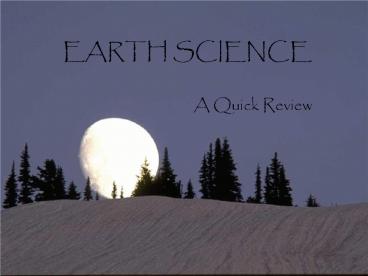EARTH SCIENCE - PowerPoint PPT Presentation
1 / 40
Title:
EARTH SCIENCE
Description:
... Thin rigid Contains the crust ... Earth s Crust Earth s Crust Volcanoes Volcanoes Earthquakes Earthquakes Rock Cycle Slide 24 Rock Cycle Soil Earth ... – PowerPoint PPT presentation
Number of Views:106
Avg rating:3.0/5.0
Title: EARTH SCIENCE
1
EARTH SCIENCE
- A Quick Review
2
Where are we?
- 3rd planet from the sun
- About 92 million miles
- Perfect distance to balance warmth
- The Water Planet
3
Who are we?
- Geosphere
- Hydrosphere
- Atmosphere
- Biosphere
4
Earths History
- About 4.6 billion years old (according to rock
record) - Geologic Time scale - broken down into eons,
eras, periods and epochs. (Precambrian epoch
87 of time scale)
5
Earths History
- Divisions mainly dependent on rise of certain
types of organisms or major events.
6
Earths Composition
- 3 major concentric zones
- Core
- Solid inner due to pressure (Ni Fe)
- Molten outer - creates magnetic field (Fe S)
- Mantle
- Mostly solid
- Asthenosphere slowly flowing
- Lithosphere
- Thin rigid
- Contains the crust
7
Earths Magnetic Field
8
Earths Crust
- Oceanic crust mostly basalt (more dense,
3.0g/cm3) - Continental crust mostly granite (less dense,
2.7g/cm3)
9
Plate Tectonics
- Nuclear decay in the core releases heat into the
mantle and asthenosphere causing convection
currents that create plate movement
10
Plate Tectonics
- Convection currents have caused the mass movement
of plates over millions of years.
11
Plate Tectonics
- The movement of these plates is called
Continental Drift.
12
Plate Tectonics
- Each individual plate (about 12) is made of
lithosphere and mantle.
13
Plate Tectonics
- Today, the plates are still in motion
- PLATE TECTONICS
- http//sos.noaa.gov/videos/Paleo3.mov
14
Plate Tectonics
- The plates today
15
Plate tectonics
- Plate boundaries edges of the plates
- Three types convergent, divergent and transform
16
Earths Crust
- Convergence
- (subduction)
- Creates mountains and volcanoes
17
Earths Crust
- Divergence (ridge formation)
- Creates volcanoes and new crust
18
Earths Crust
- Transform plates sliding past one another.
- Creates earthquakes
19
Volcanoes
- Active
- Dormant
- Extinct
- Subduction volcanoes
- At plate boundaries
- Hot spot volcanoes
- In the middle of plates
20
Volcanoes
- Rift Volcanoes
- Form new oceanic crust
21
Earthquakes
- Each black dot is the location of an earthquake
22
Earthquakes
- Anatomy
- Fault
- Focus
- Epicenter
- Waves
23
Rock Cycle
- Rocks come from rocks
- Time, erosion, pressure and heat create 3 basic
types - Igneous
- Sedimentary
- Metamorphic
24
(No Transcript)
25
Rock Cycle
- Erosion
26
Soil
- A crucial link between biotic (living) and
abiotic (nonliving)
27
Earths orbit and rotation
- Revolution, rotation and tilt determine our days
and seasons.
28
Seasons
- Spring in the Northern, Autumn in the Southern
29
Seasons
- Summer in the Northern, Winter in the Southern
30
Seasons
- Autumn in the Northern, Spring in the Southern
31
Seasons
- Winter in the Northern, Summer in the Southern
32
The Atmosphere
- A layer of gases held close to the Earth by
gravity - With the help of the sun, its where our weather
and climates occur
33
Atmosphere
- Troposphere all of the weather, most of the
water vapor and clouds. - Well mixed layer.
- Area of the atmosphere that holds the greenhouse
gases
34
The Greenhouse Effect
- Without the greenhouse gases (CO2, H2O, and CH4)
in the atmosphere, we wouldnt survive.
35
Atmosphere
- Stratosphere not well mixed.
- Contains the ozone layer (O3)
36
Atmosphere
- Mesosphere where meteors usually burn up.
37
Atmosphere
- Thermosphere (or Ionosphere)
- Thinnest gas layer
- Auroras
- Space shuttles
- Ionization (absorption of solar wind)
- Reflects radio waves
38
Atmosphere
- Exosphere
- Satellites
- Lightest gases H2 and He
39
Atmosphere
- Magnetosphere area where the magnetic field of
the earth dominantly controls the movements of
gas and charged particles.
40
Hydrosphere Biosphere
- Well cover these later..































